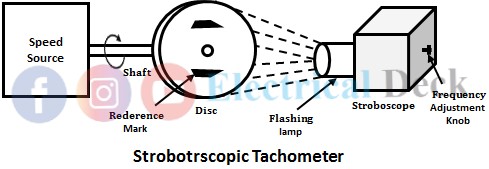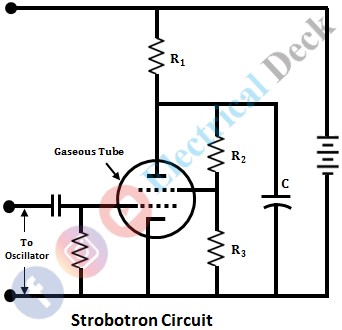What is a Stroboscope?
A stroboscope or strobe is an instrument that works on the phenomenon of stroboscopic effect. It creates a stop motion effect of a rotating object by flashing a high-intensity light on it. This appearance of a moving object to be stationary can be used to study rotating, oscillating or vibrating objects.
Hence, a stroboscopic instrument can be used for the measurement of rotational speed or rotary motion or angular velocity (RPM) of a motor or any rotating object. Angular speeds ranging between 600 to 20000 rpm can be measured with the help of a stroboscope tachometer. A stroboscope tachometer uses a variable frequency flashing light called strobotron.
Stroboscope Tachometer :
A stroboscope or stroboscopic tachometer is also called a flashlight stroboscope used for the measurement of angular velocity or rotational speed by the stroboscopic method. It consists of a flashing light of variable frequency in which the flashing frequency of the stroboscope light can be adjusted.
A variable frequency oscillator is employed to control the flashing frequency of the light. By adjusting the oscillator frequency the angular speed can be measured. The below shows the measurement of rotational speed using the stroboscopic method.
In order to measure the angular velocity of a shaft or any rotating body. A disc with distinctive marks is mounted to the rotating shaft whose angular velocity is to be measured. The stroboscope is provided with a neon gas discharge bulb. The stroboscope is adjusted such that the light flashes directly on the reference marks.
The frequency of these flashes is varied and adjusted by means of a frequency adjustment knob until the reference marks on the disc appear to be stationary.
This occurs when the frequency of the flash lamp is equal to the speed of rotation of the reference marks on the disk and hence the shaft. Thus, the frequency of flashing light of stroboscope gives the angular velocity or speed when calibrated in terms of speed.
Strobotron :
Strobotron is a device that is used as the source of flashing light in a stroboscopic method of measuring angular velocity. Strobotron is a hot cathode gaseous discharge tube that consists of two electrodes (cathode and anode) and two grids (inner grid and outer grid).
The conduction in the discharge tube starts, when the potential of the inner grid is less than or the potential of the outer grid is more than a particular value. Then, in order to stop the conduction, the anode potential must be made zero.
A variable frequency oscillator is a part of the strobotron circuit and it is connected to the gaseous discharge tube as shown in the figure above. The oscillator supplies a signal which is responsible for the flashing of light. When the strobotron (gaseous tube) receives an oscillating signal from the oscillator, the ionized tube starts flashing.
Due to the flashing process, the capacitor C gets discharged. In order to recharge again, capacitor C draws a large amount of current. This leads to a high voltage drop across the resistor R, which in turn leads to a decrease in anode potential.
The decrease in anode potential stops the ionization of the gas in the discharge tube and hence the flashing of the light also stops. The flashing of light starts again when it receives the next pulse from the oscillator. By varying the frequency of the oscillator (i.e., oscillating signal) the frequency of the flashing of the light can be varied and thus controlled.


